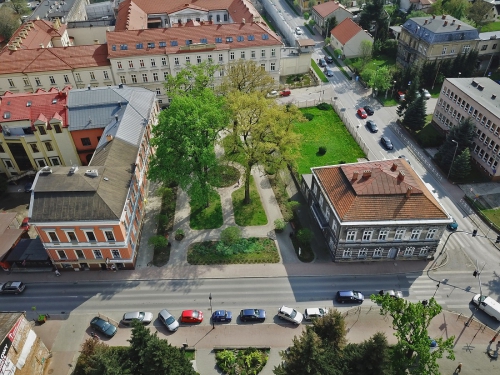One of the most interesting urban features found in the Galician town of Wadowice is the garden square situated between the building of the Circuit Court on the southern side, the tenement house of Izydor Daniel on the west, the Gymnasium building on the north and the residential houses of the Leiblers and Andrzej Marekowski on the eastern side. In 1887 a plinth with a bust of the Austrian Baron Josef Baum von Appelshofen (1821-1883) was erected at its central point. He was born to a Saxon family which had settled in Poland and made himself known as a local political and social activist. In the 1870s he became personally involved in the advocation of the establishment of the Circuit Court in Wadowice. The baron’s monument became a permanent landmark in the Galician landscape of Wadowice. However, the monument has not survived to the present time.
Building of the Imperial and Royal Gymnasium of Humanities in Wadowice
In 1866, after over 30 years of efforts, the central authorities in Vienna gave permission for the opening of the Gymnasium of Humanities in Wadowice. Until 1895, it was the only Polish Gymnasium in Galicia west of Cracow. For the impoverished young people from the neighbouring counties, education in Wadowice was usually the only viable route to the matriculation examination and then later to medical, legal or theological studies or to a military career. The level of education was very high, which is evidenced by the careers of graduates in those days. Those worthy of a mention include St Józef Biba Bilczewski (1860-1923), General Walerian Czuma (1890-1962), prof. Stanisław Witkowski (1866-1950) and the writer Emil Zegadłowicz (1888-1941). Initially, the Gymnasium was housed in the Municipal Office building. The construction of a new headquarters was a prerequisite imposed by the Vienna government for keeping the Gymnasium in Wadowice. The ceremonial opening of the school building took place in 1875 and was attended by the local officials and the school students.
Building of the old Circuit Court in Wadowice
A special place in the public urban space of the 19th-century Wadowice was occupied by the building of the courthouse and prison. In 1876, the Presidium of the Imperial and Royal National High Court in Cracow, with the consent of Emperor Franz Joseph, established the Circuit Court in Wadowice. The town was obliged to prepare a seat for the court. The Town Councillors made the decision to erect a new, modern building. The construction was completed in 1881, and a year later the ceremonial inauguration of the court took place. The town gained the status of a seat of the Circuit Court and thus became the most important judicial centre west of Cracow. From that moment its jurisdiction covered one County Court in Wadowice as well as eleven subordinate courts in Andrychów, Biała, Jordanów, Kalwaria, Kęty, Maków, Milówka, Myślenice, Oświęcim, Ślemień and Żywiec, and, from 1892, also in Zator. The location of the seat of the court in Wadowice was a sign of the prestige and high status of the town in the urban structures of Galicia in those days. At the turn of the 20th century, some famous trials were held here and were followed with great interest by the public not only in Austria but also across Europe. The famous trial of Wanda Krahelska-Dobrodzicka (17-18.02.1908): Krahelska was a member of the Revolutionary Faction of the Polish Socialist Party and in August 1906, took part in a failed bomb assassination attempt on the Russian Governor-General of Warsaw, gen. Jerzy Antonowicz Skałon. Wadowice was chosen to be the venue of the trial. The Polish jury acquitted Krahelska of the charges brought against her. Outside the courthouse, crowds of town inhabitants and gaping onlookers, who had come to Wadowice especially for this occasion, were waiting for the Polish heroine. Outside the entrance a makeshift wooden triumphal gate was erected, and Krahelska was carried through it upon leaving the courthouse. Krahelska’s defence lawyer was the Wadowice-based advocate, Stanisław Łazarski (1849-1938). Participation in this trial brought him fame as a lawyer. On recommendation of Józef Piłsudski, he was
The tenement houses of the Leiblers and Andrzej Marekowski
The Courthouse Garden is adjacent, on the east side, to the Leiblers’ tenement house, which was connected into one structure with the house (closer to the courthouse) belonging to a local advocate, Andrzej Marekowski – a participant of the 1863 January Uprising. Due to the location of Marekowski’s house, some law offices had their seats in it. The people whose lives are associated with the house include the writer and dramatist Adolf Nowaczyński (1876-1944) and most famously, Stefan Kotlarczyk (1874-1931), a local cultural activist and the father of Mieczysław (1907-1978) – the founder and manager of the famous Teatr Rapsodyczny (Rhapsodic Theatre) in Cracow.
Izydor Daniel’s house
The growing affluence among the towns people of Wadowice meant that brick houses and tenements became a permanent feature of the Galician town towards the close of the 19th century. They were erected not only in the market place but also along the major streets diverging from the town centre. Some of them have remained landmarks of Wadowice until the present day and form the jewel of bourgeois architecture of the Galician period. One such house is the freestanding building in the western part of the Courthouse Garden, in Mickiewicza Street, formerly Wiedeńska (Vienna) Street. It was constructed by a local advocate, Izydor Daniel (1852-1917/1918) – one of the most distinguished citizens of Wadowice in those days.

